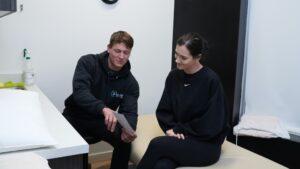Knee injuries are, unfortunately, very common. We see patients coming into our Synergy Rehab clinic all the time managing their knee aches and pains. This makes sense. The knee joint is a complex structure and its key role in supporting body weight and facilitating movement makes it susceptible to various forces and stresses during physical activity.
Medial collateral ligament (MCL) knee injuries can be particularly debilitating. Whether due to sports, accidents, or everyday activities, MCL injuries can significantly impact one’s mobility and quality of life. In this post, our physical therapy and sports med experts delve into the symptoms, differences between MCL tears and sprains, the healing process, and how physiotherapy can play a crucial role in your knee injury recovery.

What are the main symptoms of an MCL injury?
The MCL is a band of tissue that runs along the inner edge of your knee, connecting the thigh bone to the shin bone. When this ligament is injured, it can result in a range of symptoms, including:
- Pain and tenderness along the inner side of the knee.
- Swelling, which may develop rapidly following the injury.
- Knee instability or a feeling that the knee may give out.
- Difficulty with knee flexion—a struggle to bend or straighten your knee fully.
- Bruising around the knee joint.
- A popping sound at the time of injury, indicating a tear.
These symptoms can vary in severity depending on the extent of the injury, ranging from mild discomfort to significant pain and impairment.
MCL tear vs. MCL sprain
Understanding the difference between a medial collateral ligament tear and sprain is crucial for determining the appropriate course of treatment.
An MCL tear typically occurs when the ligament is stretched beyond its limits, resulting in partial or complete tearing. This injury often happens during activities that involve sudden changes in direction or direct blows to the knee, such as those commonly seen in contact sports like football or soccer. Our sports medicine specialists are primed to work with athletes in healing their MCL tear for the fastest, healthiest recovery.
On the other hand, an MCL sprain involves damage to the ligament without complete tearing. Sprains are graded based on their severity:
- Grade i sprain: Mild stretching or microscopic tearing of the ligament fibers, resulting in minimal pain and swelling.
- Grade ii sprain: Partial tearing of the ligament fibers, leading to moderate pain, swelling, and instability.
- Grade iii sprain: Severe or complete tearing of the knee ligament, causing significant pain, swelling, and instability.
How long does it take for a knee MCL injury to heal?
The healing time for an MCL injury varies depending on several factors, including the severity of the injury, the individual’s overall health, and adherence to treatment protocols. In general:
- Grade i sprains typically heal within 2-4 weeks with conservative treatment, such as rest, ice, and physiotherapy exercises
- Grade ii sprains may take 4-8 weeks to heal, often requiring a combination of conservative measures and a possible knee brace to stabilize the knee.
Grade iii tears may necessitate more intensive treatment, including immobilization, bracing, and sometimes mcl surgery. Healing time for these injuries can range from 8 weeks to several months, with rehabilitation playing a crucial role in restoring knee function and stability
How can physiotherapy help a medial collateral ligament injury?
Physiotherapy is an essential component of the treatment plan for MCL injuries, regardless of their severity. Our skilled physical therapists at Synergy Rehab design a personalized rehabilitation program aimed at:
- Reducing pain and swelling: Through modalities such as ice, ultrasound, and IMS, physiotherapy can help alleviate pain and inflammation in the acute phase of injury.
- Restoring range of motion: Gentle stretching and range of motion exercises to prevent stiffness and promote flexibility in the knee joint and knee ligament.
- Strengthening the muscles around the knee: Targeted exercises for the quadriceps, hamstrings, and calf muscles to improve stability and support the injured MCL.
- Improving balance: Balance training and proprioceptive exercises to help retrain the neuromuscular system, reducing the risk of re-injury.
- Gradual return to activity: A structured rehabilitation program to guide patients through progressive exercises and functional activities, ensuring a safe return to sports and daily activities without compromising the healing process.
In addition to in-clinic sessions, our team provides education and support to empower patients in managing their mcl injury treatment effectively, including home exercises, activity modification, and injury prevention strategies.
Do you have an injured knee? Visit a Synergy Rehab near you for help.
A knee MCL injury can be a significant setback, but with proper diagnosis, treatment, and rehabilitation, most individuals can regain full function and return to their active lifestyle.
If you’re experiencing symptoms of an MCL injury or other sports injuries, don’t hesitate to book a same-day appointment to consult with our experts—we’ve got your back.








